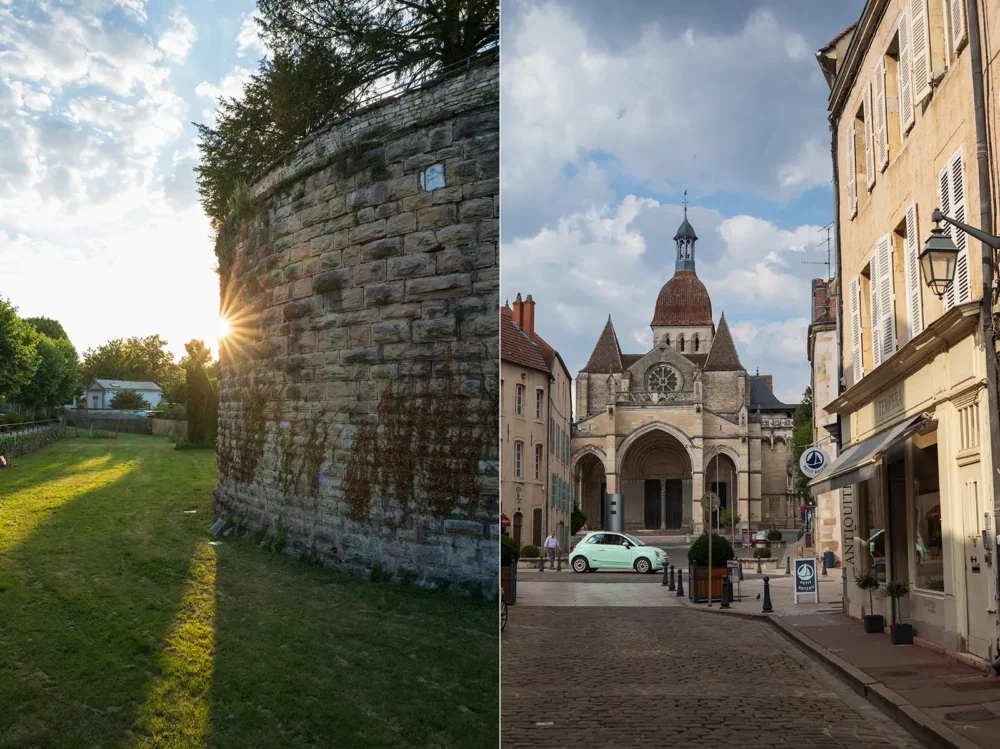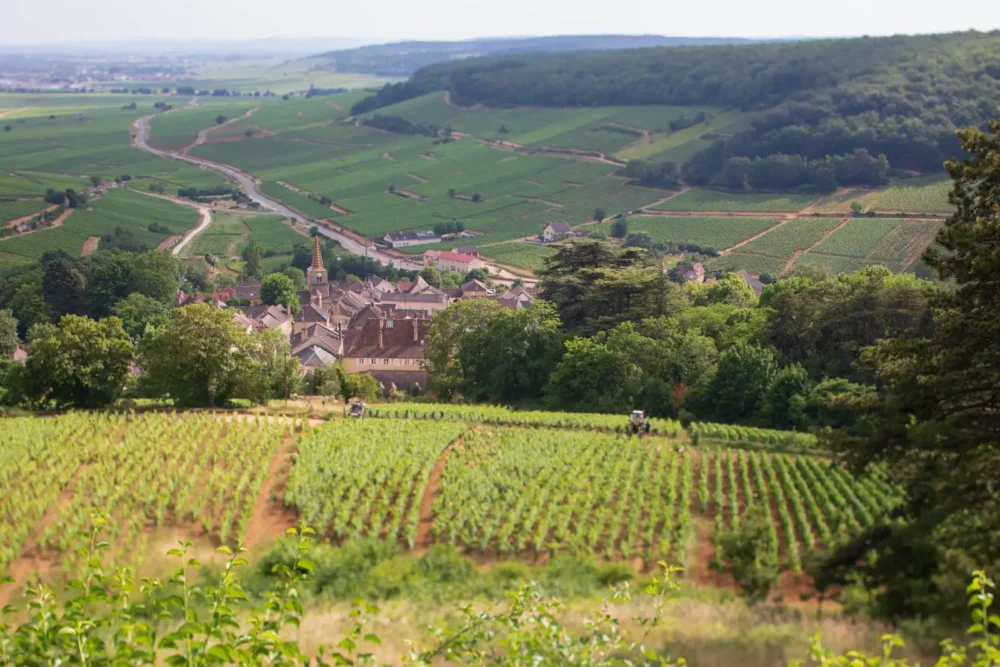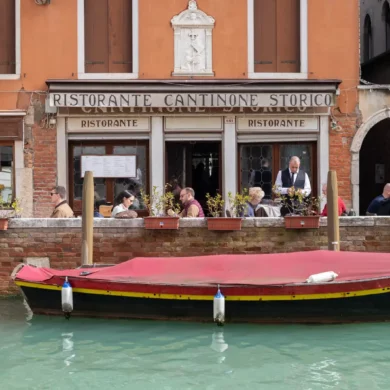Dijon may be the capital of Bourgogne, but for wine lovers, Beaune is the real heart of the region. Surrounded by highly esteemed Pinot Noir and Chardonnay vineyards, the tiny French city of just over 20,000 people is high on the wine travel bucket list of gourmands, sommeliers, collectors and anyone who has ever bothered to buy a decanter and actually use it.
You feel like at any moment, the pull of a cork will unleash an indelible vinous story — the true souvenir of your journey to this, the heart of French wine.
In fact, one could make a very convincing case that Beaune is the fine wine capital of world, but you’d never hear any of its residents refer to it as such. Despite the centuries of acclaim heaped on their vineyards and the wines they coax from them, Burgundians are not boastful people. They let their wine do the talking. Perhaps that is what makes walking around Beaune so surprising and pleasant, given its prestige: there isn’t a hint of swagger to any of the shops, restaurants and sites, just the occasional Audi TT R8 driving by (which is likely piloted by a deep-pocketed visitor anyway).
Where you will see the swagger is in the price of wines on the menu. There is no avoiding that fact: there are not enough wines from Bourgogne to satisfy global demand, and while the wines in Beaune won’t have any import duties, they still command top dollar.
However, that’s part of the intrigue of this place. You feel like at any moment, the pull of a cork will unleash an indelible vinous story — the true souvenir of your journey to this, the heart of French wine. And its not just Grand Cru wines that will set your heart aflutter, as we’ve found with our recent coverage of regional wines and the area’s top value villages.

3 Reasons to Visit Beaune
- The Mystique – You simply cannot duplicate any aspect of Beaune’s ambiance, charm and prestige.
- The History – Forget wine for a second: there are enough historical attractions here to satisfy your inner-Rick Steves for weeks on end.
- The Wine and Its Context – Wine is your passion. You might even say it is your obsession. In wine travel, you find the relevant context where it all makes sense. Considering how notoriously complex and layered Burgundian wine is, visiting Beaune is the ultimate gesture of stitching a lifetime of obsession together.
How to Reach Beaune
It is possible to reach Beaune by train from either Lyon or Paris. Since I am allergic to Paris’ Charles de Gaulle airport, I prefer the easy connection into Lyon’s Saint-Exupery airport via Frankfurt or Münich. Besides, the train system from Lyon’s airport to its Part-Dieu train station is a breeze, and the scenic ride north — along the Sâone River for much of it — takes only about an hour and 40 minutes.
If you do originate from Paris’ Charles de Gaulle, the TGV train will take you to Lyon anyway for a transfer to the same train route (a little more than four hours). Or you can go into Paris and leave Gare de Lyon train station on a TGV for Dijon and transfer south (a little more than three hours total).
By car, Beaune is a 3 hour and 45 minute drive from Paris, and an hour and 45 minute drive from Lyon.
Beaune’s Lay of the Land
Beaune is in the heart of the UNESCO World Heritage site known as Les Climats du Vignoble de Bourgogne, which was designated in 2015. This expansive site covers the city of Dijon all the way to the vineyards of Sampigny-les-Maranges, and is devoted to preserving the historic system of highly specific parcelization in viticulture that has made Bourgogne and its wines so famous.
The city of Beaune is the centerpiece of this World Heritage site — a delightfully medieval town with a tidy ring road encompassing its ancient alleyways and the charming La Bouzaize, a small river that was once put to good use. Place Carnot is the main city square, with the Basilique Notre-Dame de Beaune and Hôtel Dieu-Hospices de Beaune anchoring the cityscape a few blocks away.
The ridge of vineyards reaching north-northeast from the city is known as the Côte de Nuits, and it is best-known for exemplary Pinot Noir. The Côte de Beaune stretches south-southwest, and while it too is known for Pinot Noir, certain parcels are famous for yielding the world’s most coveted Chardonnay. Both escarpments are an easy and short drive from Beaune.

Where to Start with the Wines of Bourgogne: Cité des Climats et Vins de Bourgogne-Beaune
This new museum, which opened in 2023, explores the unique terroir and history of Bourgogne through a series of exhibits and events. The centerpiece of the museum is the “visitor trail” — an expansive room filled with interactive, hands-on exhibits that will give you a firm sense for the totality of Burgundian wine.
Partner museums in Chablis and Mâcon have also opened, creating what local authorities hope will be a go-to route for tourists.
What to See (Besides Vineyards and Caves): Hôtel Dieu-Hospices de Beaune

Is there a more beautiful hospital in the world than this? With its roof of interwoven green, red, gold and black lines — entirely made of Flemish roofing tiles — the Hôtel Dieu-Hospices de Beaune has been a visual icon of Bourgogne and its wine industry for centuries.
Wait a second … The hospital has a wine connection?
It sure does. Established as a hospital for the poor in 1443, and built in the 1450s, the building tended to patients all the way into the 1970s, when the need for more modern facilities prompted a move. Today, the Hôtel Dieu-Hospices de Beaune is a museum, and annually it hosts a famous wine auction to benefit the hospital’s charity.
Where to Hang in a Wine Bar: La Dilettante
From the sidewalk, La Dilettante has “the look.” First, there are the wood-framed windows lined with empty bottles of esteemed wines long-ago sipped. Then there is the wine barrel on the sidewalk with a stenciled portrait of an iconic vigneron, and the sort of all-caps sign announcing LA DILETTANTE that screams “yep, I am in France.” You just hope the service, food and wine list fulfills the promise.
Well, it does.
La Dilettante is a very good wine bar, with a low-key celebratory ambiance and knowledgeable service. My travel companion and I debated long and hard over which bottle to order. Odds are, you will too. But it is popular, so score a reservation in advance. (No, they don’t have Open Table. You have to call 33 3 80 21 48 59).

Where to Grab Dinner (Option 1): L’Ardoise
When I dined in Beaune last, it was the beginning of summer, and while an atmospheric wine cave-turned-dining room has its place (no shortage of those in Beaune), being able to savor the evening on a lovely patio was a nice change of pace. L’Ardoise provided and then some.
Chef Matheiu Gaudeau’s haute cuisine has respectful touches from Thailand, Japan and Spain which somehow all seem to make sense over multiple courses. The wine list, while extensive, earns bonus points for touching upon a variety of price points.
Where to Grab Dinner (Option 2): Le Caveau des Arches
That wine cave-turned-restaurant ambiance I mentioned? Go here to find it. Or maybe you just want a classy wine bar to sink into? Again, go here to find it (just stay upstairs at street level).

Le Caveau des Arches was established in the 1990s, but the subterranean dining room — a spectacular tunnel of bricks — hails from the 15th century. The restaurant offers two set menus (Burgundian or Traditional) and very attentive service.
Where to Buy Mustard & Picnic Provisions: Vossot Raphaël Sarl
I am not the type of person to stay in a place for multiple nights and eat every meal — morning to night — in a restaurant. I crave a little DIY, which is what makes a place like Vossot Rapaël Sarl so essential. Need picnic provisions? A mustard souvenir to pack in your suitcase? A counter to practice your French? Look for the “Boucherie Charcuterie” sign on Rue Maufoux.
What to Do (Besides Taste and Drink and Eat and Repeat): Cycling

While wine lovers obsess over every pitch and nuanced angle of the Côte de Nuits and Côte de Beaune, a majority of the area around the city of Beaune is flat as a pancake. For cyclists, this has long been a huge benefit: you can cover more ground in a day than other notable European wine regions (good luck tackling Barolo’s hills, for instance).
Enhancing cyclist safety is the Voie des Vignes, a nearly 50-mile path reserved for cyclists and pedestrians which winds its way through the vineyards, passing clos walls, dazzling chateaux and many of the regions most famous wine villages along the way.
From Beaune, the Voie des Vignes takes you north along the Côte de Nuits through Aloxe-Corton, Chambolle-Musigny, Clos Vougeot and Marsannay to the historic city of Dijon. Meanwhile, to the south it connects to Santenay and Nolay via Pommard, Volnay, Meursault and Puligny-Montrachet. You can rent standard bikes or e-bikes in Beaune.
If You Only Have Time to See One Village: Pernand-Vergelesses
Beyond visiting vineyards and tasting wine, there is not much to see and do in the villages surrounding Beaune. Their charm lies in their scenic qualities, and the ability to walk among vines that produce some of the most coveted wines on earth.

For this latter reason, most everyone heads to Vosne-Romanée to have their selfie taken by the cross marking the Grand Cru Romanée. (Or, if their blanc inclined, they go south to do the same with Montrachet). However, for picturesque beauty, it is hard to beat Pernand-Vergelesses. Tucked in a cleft between an escarpment and the great hill of Corton, the tiny enclave also boasts some exceptional wineries to visit, such as Rapet, Pavelot and Delarche. A tasting in this village will also familiarize you with some unheralded Premier Crus which might become new favorites. Head to the oratoire above town for a lay of the land, and toast to this (somewhat) hidden gem.
A word of advise on visiting any of the area’s wineries: an appointment is essential. These are mostly small family operations and certain times of the year can be too busy to accommodate visitors, so be patient and gracious.
Lastly, Where to Stay in Beaune: Abbaye de Mazieres
During my recent stay, my accommodations were decent, but ultimately nothing too distinctive for this guide. So I asked a wine industry pro who knows better than I do on the hotel front: wine importer Zach Locke of Old World Wine in Colorado. Locke regularly visits Beaune to meet with clients and scout new producers, and of the accommodations he has recently stayed in, Abbaye de Mazieres rises to the top.
“It is a boutique hotel — a cool, and very different property,” he told me, adding that its prime location and well-appointed breakfast make it an ideal spot for his purposes.
On the budget end of things, Locke recommends Hotel Athanor, in part because of its location in the heart of the city.
Note: My last trip to Bourgogne was part of a press trip organized and paid for by Bourgogne Wine Board. I was allowed the autonomy to request wineries, and to explore the city on my own in my free time. The recommendations in this article (minus the accommodations at the end) are entirely my own. Learn more about our editorial policy.



